TAXATION LAW: Analysis of Fringe Benefits and Income Tax Implications
VerifiedAdded on 2020/05/16
|10
|1780
|26
Homework Assignment
AI Summary
This assignment solution addresses key aspects of Australian Taxation Law, specifically focusing on fringe benefits and income tax. The first part analyzes a scenario involving a company providing a car to an employee, determining the implications of fringe benefit tax (FBT) under the FBTAA, considering both statutory and operating cost methods for calculating the taxable value. The second part explores income tax principles, differentiating between income tax and capital gains tax, assessing the taxability of gifts received by a professional, distinguishing between a business and a hobby, and examining the tax implications of barter transactions under the ITAA, referencing relevant case law and tax rulings. The solution provides a detailed breakdown of the relevant sections of the FBTAA and ITAA, applying them to the given scenarios to arrive at the correct tax outcomes.
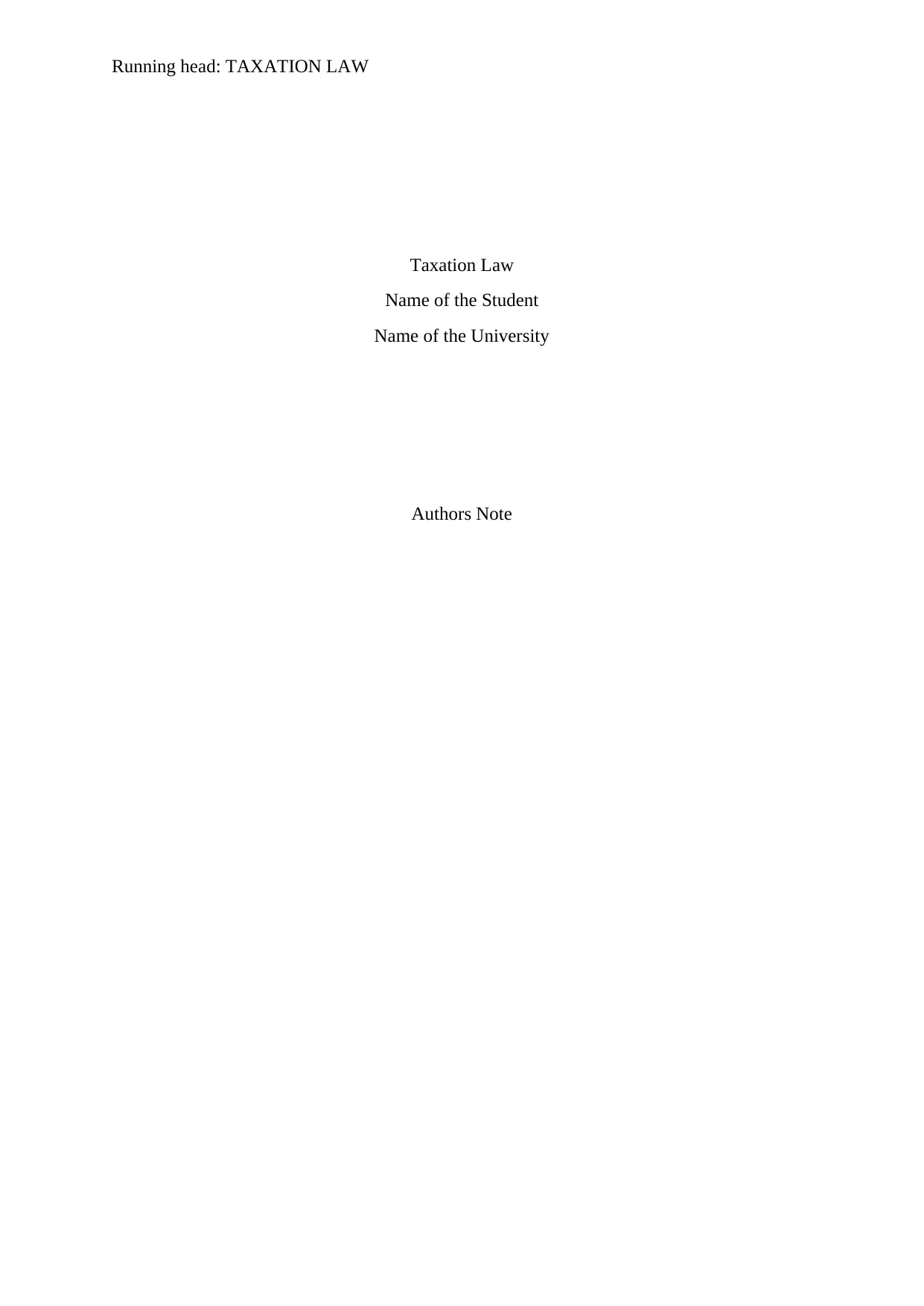
Running head: TAXATION LAW
Taxation Law
Name of the Student
Name of the University
Authors Note
Taxation Law
Name of the Student
Name of the University
Authors Note
Paraphrase This Document
Need a fresh take? Get an instant paraphrase of this document with our AI Paraphraser
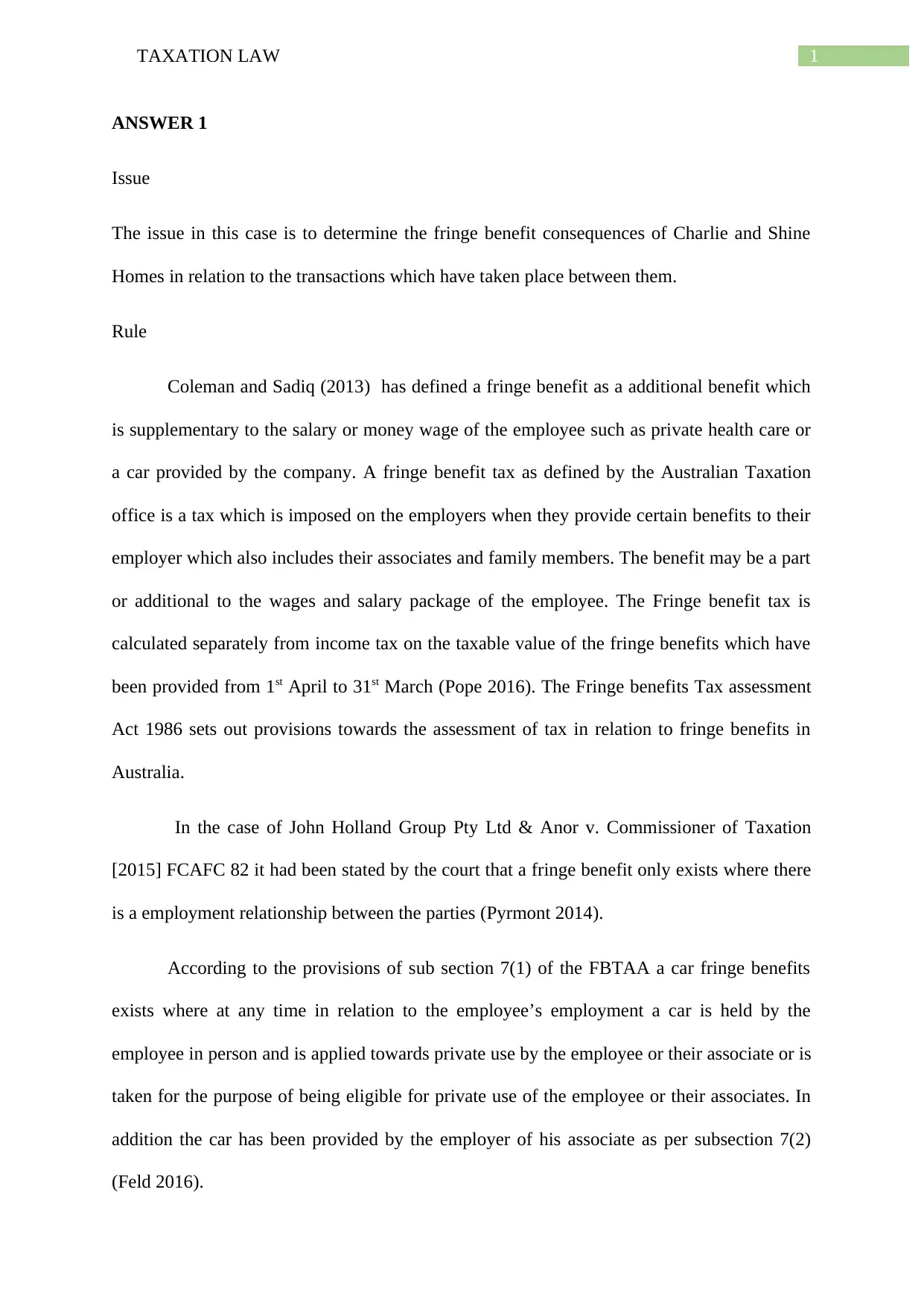
1TAXATION LAW
ANSWER 1
Issue
The issue in this case is to determine the fringe benefit consequences of Charlie and Shine
Homes in relation to the transactions which have taken place between them.
Rule
Coleman and Sadiq (2013) has defined a fringe benefit as a additional benefit which
is supplementary to the salary or money wage of the employee such as private health care or
a car provided by the company. A fringe benefit tax as defined by the Australian Taxation
office is a tax which is imposed on the employers when they provide certain benefits to their
employer which also includes their associates and family members. The benefit may be a part
or additional to the wages and salary package of the employee. The Fringe benefit tax is
calculated separately from income tax on the taxable value of the fringe benefits which have
been provided from 1st April to 31st March (Pope 2016). The Fringe benefits Tax assessment
Act 1986 sets out provisions towards the assessment of tax in relation to fringe benefits in
Australia.
In the case of John Holland Group Pty Ltd & Anor v. Commissioner of Taxation
[2015] FCAFC 82 it had been stated by the court that a fringe benefit only exists where there
is a employment relationship between the parties (Pyrmont 2014).
According to the provisions of sub section 7(1) of the FBTAA a car fringe benefits
exists where at any time in relation to the employee’s employment a car is held by the
employee in person and is applied towards private use by the employee or their associate or is
taken for the purpose of being eligible for private use of the employee or their associates. In
addition the car has been provided by the employer of his associate as per subsection 7(2)
(Feld 2016).
ANSWER 1
Issue
The issue in this case is to determine the fringe benefit consequences of Charlie and Shine
Homes in relation to the transactions which have taken place between them.
Rule
Coleman and Sadiq (2013) has defined a fringe benefit as a additional benefit which
is supplementary to the salary or money wage of the employee such as private health care or
a car provided by the company. A fringe benefit tax as defined by the Australian Taxation
office is a tax which is imposed on the employers when they provide certain benefits to their
employer which also includes their associates and family members. The benefit may be a part
or additional to the wages and salary package of the employee. The Fringe benefit tax is
calculated separately from income tax on the taxable value of the fringe benefits which have
been provided from 1st April to 31st March (Pope 2016). The Fringe benefits Tax assessment
Act 1986 sets out provisions towards the assessment of tax in relation to fringe benefits in
Australia.
In the case of John Holland Group Pty Ltd & Anor v. Commissioner of Taxation
[2015] FCAFC 82 it had been stated by the court that a fringe benefit only exists where there
is a employment relationship between the parties (Pyrmont 2014).
According to the provisions of sub section 7(1) of the FBTAA a car fringe benefits
exists where at any time in relation to the employee’s employment a car is held by the
employee in person and is applied towards private use by the employee or their associate or is
taken for the purpose of being eligible for private use of the employee or their associates. In
addition the car has been provided by the employer of his associate as per subsection 7(2)
(Feld 2016).
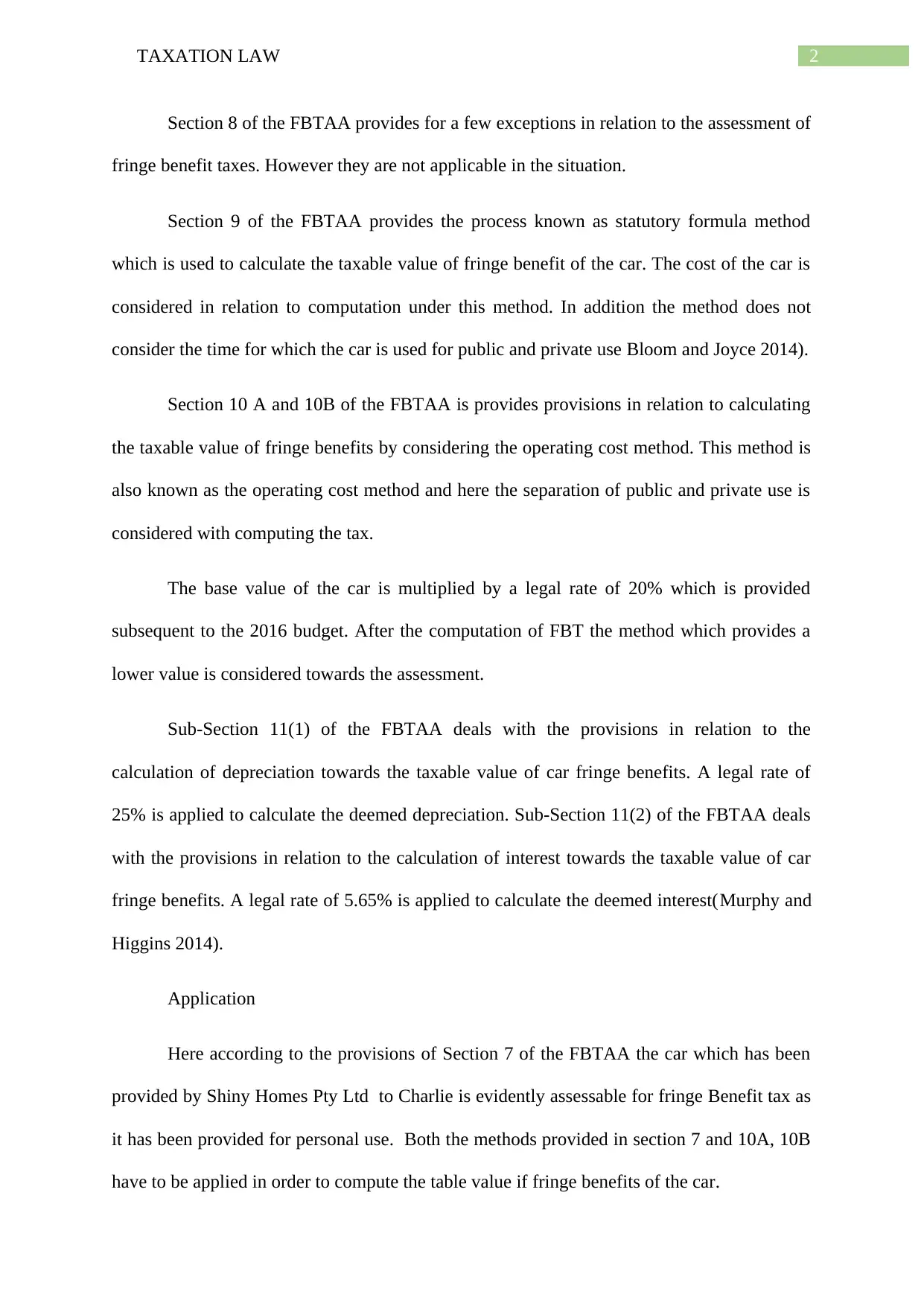
2TAXATION LAW
Section 8 of the FBTAA provides for a few exceptions in relation to the assessment of
fringe benefit taxes. However they are not applicable in the situation.
Section 9 of the FBTAA provides the process known as statutory formula method
which is used to calculate the taxable value of fringe benefit of the car. The cost of the car is
considered in relation to computation under this method. In addition the method does not
consider the time for which the car is used for public and private use Bloom and Joyce 2014).
Section 10 A and 10B of the FBTAA is provides provisions in relation to calculating
the taxable value of fringe benefits by considering the operating cost method. This method is
also known as the operating cost method and here the separation of public and private use is
considered with computing the tax.
The base value of the car is multiplied by a legal rate of 20% which is provided
subsequent to the 2016 budget. After the computation of FBT the method which provides a
lower value is considered towards the assessment.
Sub-Section 11(1) of the FBTAA deals with the provisions in relation to the
calculation of depreciation towards the taxable value of car fringe benefits. A legal rate of
25% is applied to calculate the deemed depreciation. Sub-Section 11(2) of the FBTAA deals
with the provisions in relation to the calculation of interest towards the taxable value of car
fringe benefits. A legal rate of 5.65% is applied to calculate the deemed interest(Murphy and
Higgins 2014).
Application
Here according to the provisions of Section 7 of the FBTAA the car which has been
provided by Shiny Homes Pty Ltd to Charlie is evidently assessable for fringe Benefit tax as
it has been provided for personal use. Both the methods provided in section 7 and 10A, 10B
have to be applied in order to compute the table value if fringe benefits of the car.
Section 8 of the FBTAA provides for a few exceptions in relation to the assessment of
fringe benefit taxes. However they are not applicable in the situation.
Section 9 of the FBTAA provides the process known as statutory formula method
which is used to calculate the taxable value of fringe benefit of the car. The cost of the car is
considered in relation to computation under this method. In addition the method does not
consider the time for which the car is used for public and private use Bloom and Joyce 2014).
Section 10 A and 10B of the FBTAA is provides provisions in relation to calculating
the taxable value of fringe benefits by considering the operating cost method. This method is
also known as the operating cost method and here the separation of public and private use is
considered with computing the tax.
The base value of the car is multiplied by a legal rate of 20% which is provided
subsequent to the 2016 budget. After the computation of FBT the method which provides a
lower value is considered towards the assessment.
Sub-Section 11(1) of the FBTAA deals with the provisions in relation to the
calculation of depreciation towards the taxable value of car fringe benefits. A legal rate of
25% is applied to calculate the deemed depreciation. Sub-Section 11(2) of the FBTAA deals
with the provisions in relation to the calculation of interest towards the taxable value of car
fringe benefits. A legal rate of 5.65% is applied to calculate the deemed interest(Murphy and
Higgins 2014).
Application
Here according to the provisions of Section 7 of the FBTAA the car which has been
provided by Shiny Homes Pty Ltd to Charlie is evidently assessable for fringe Benefit tax as
it has been provided for personal use. Both the methods provided in section 7 and 10A, 10B
have to be applied in order to compute the table value if fringe benefits of the car.
⊘ This is a preview!⊘
Do you want full access?
Subscribe today to unlock all pages.

Trusted by 1+ million students worldwide
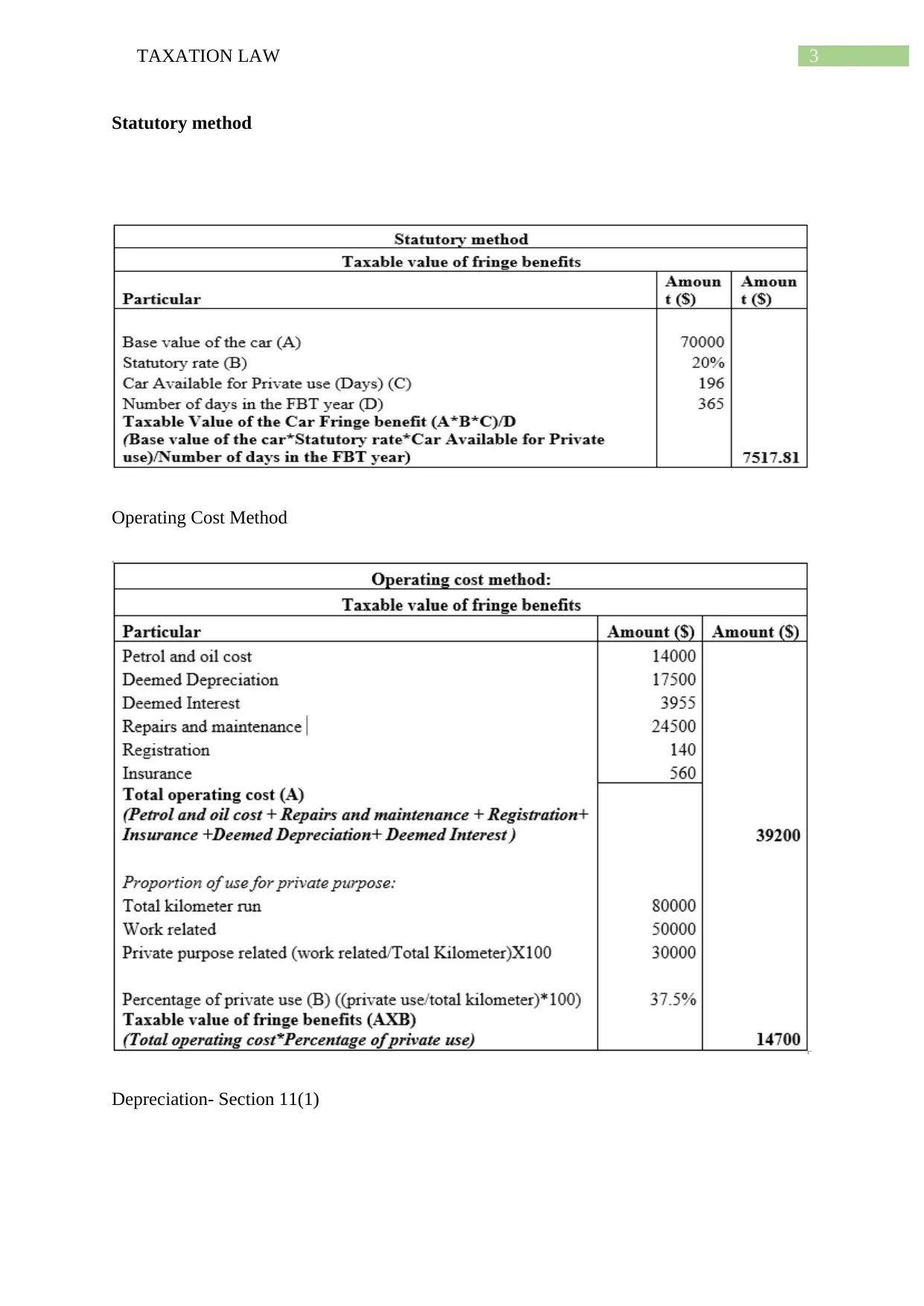
3TAXATION LAW
Statutory method
Operating Cost Method
Depreciation- Section 11(1)
Statutory method
Operating Cost Method
Depreciation- Section 11(1)
Paraphrase This Document
Need a fresh take? Get an instant paraphrase of this document with our AI Paraphraser
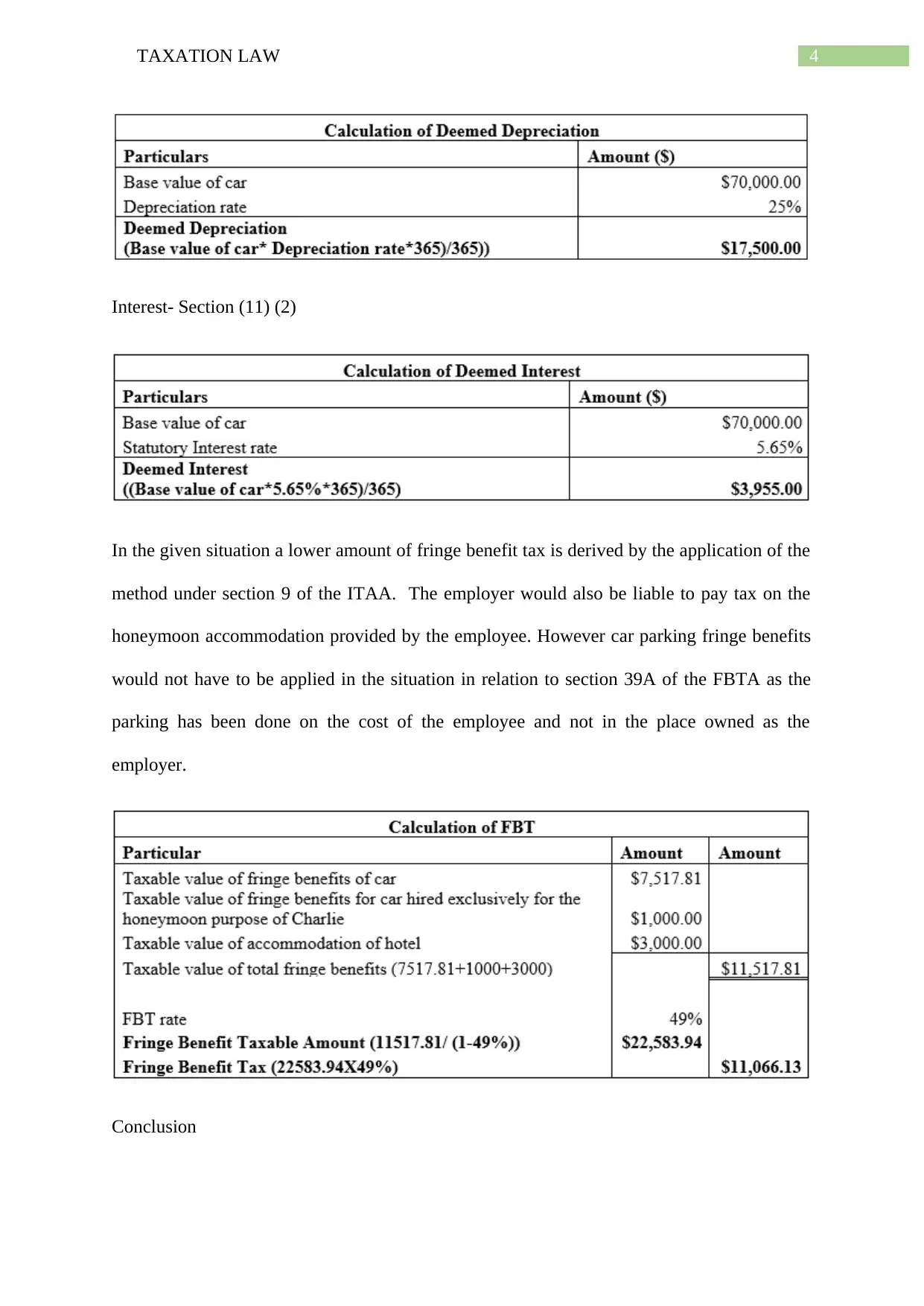
4TAXATION LAW
Interest- Section (11) (2)
In the given situation a lower amount of fringe benefit tax is derived by the application of the
method under section 9 of the ITAA. The employer would also be liable to pay tax on the
honeymoon accommodation provided by the employee. However car parking fringe benefits
would not have to be applied in the situation in relation to section 39A of the FBTA as the
parking has been done on the cost of the employee and not in the place owned as the
employer.
Conclusion
Interest- Section (11) (2)
In the given situation a lower amount of fringe benefit tax is derived by the application of the
method under section 9 of the ITAA. The employer would also be liable to pay tax on the
honeymoon accommodation provided by the employee. However car parking fringe benefits
would not have to be applied in the situation in relation to section 39A of the FBTA as the
parking has been done on the cost of the employee and not in the place owned as the
employer.
Conclusion
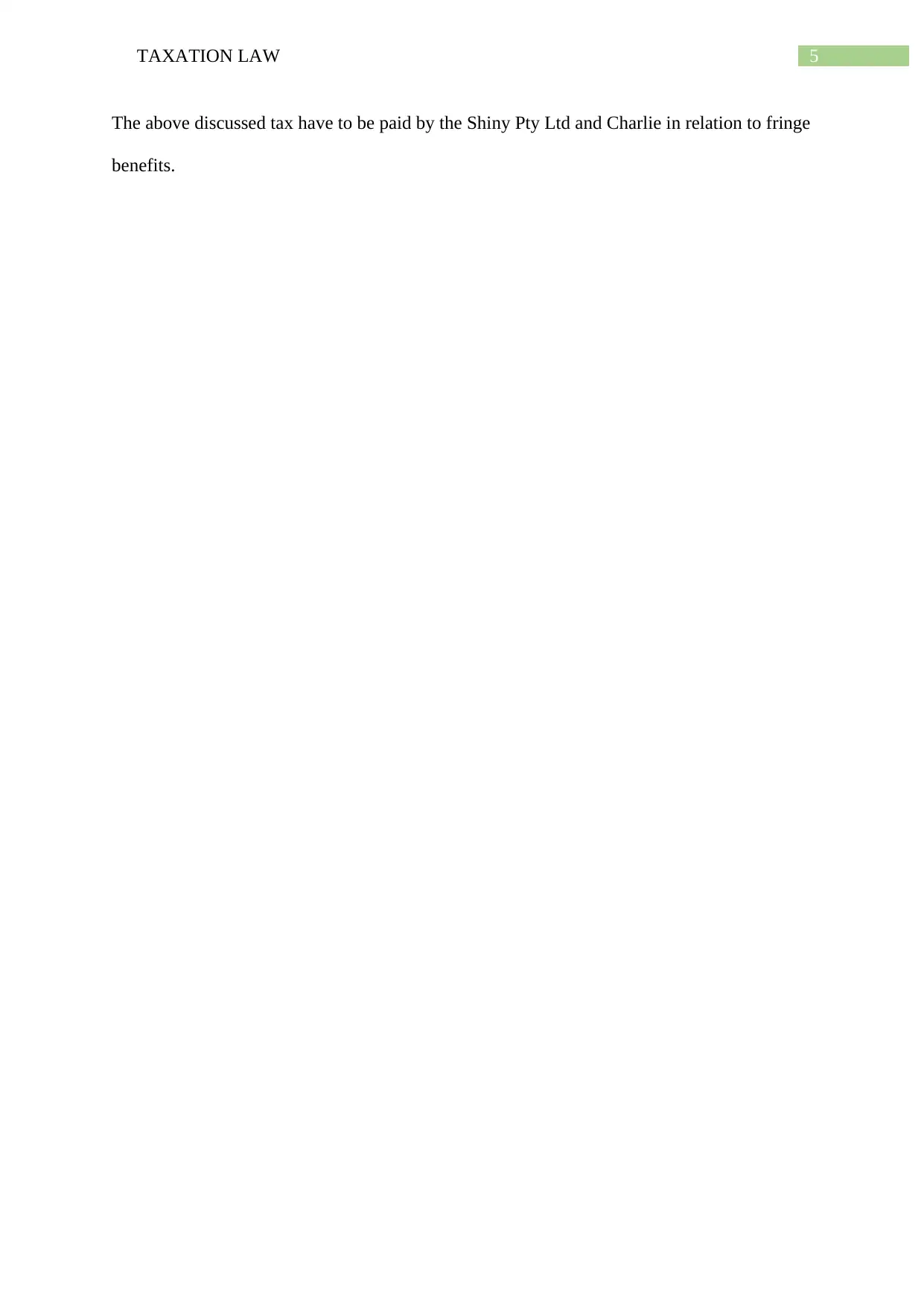
5TAXATION LAW
The above discussed tax have to be paid by the Shiny Pty Ltd and Charlie in relation to fringe
benefits.
The above discussed tax have to be paid by the Shiny Pty Ltd and Charlie in relation to fringe
benefits.
⊘ This is a preview!⊘
Do you want full access?
Subscribe today to unlock all pages.

Trusted by 1+ million students worldwide
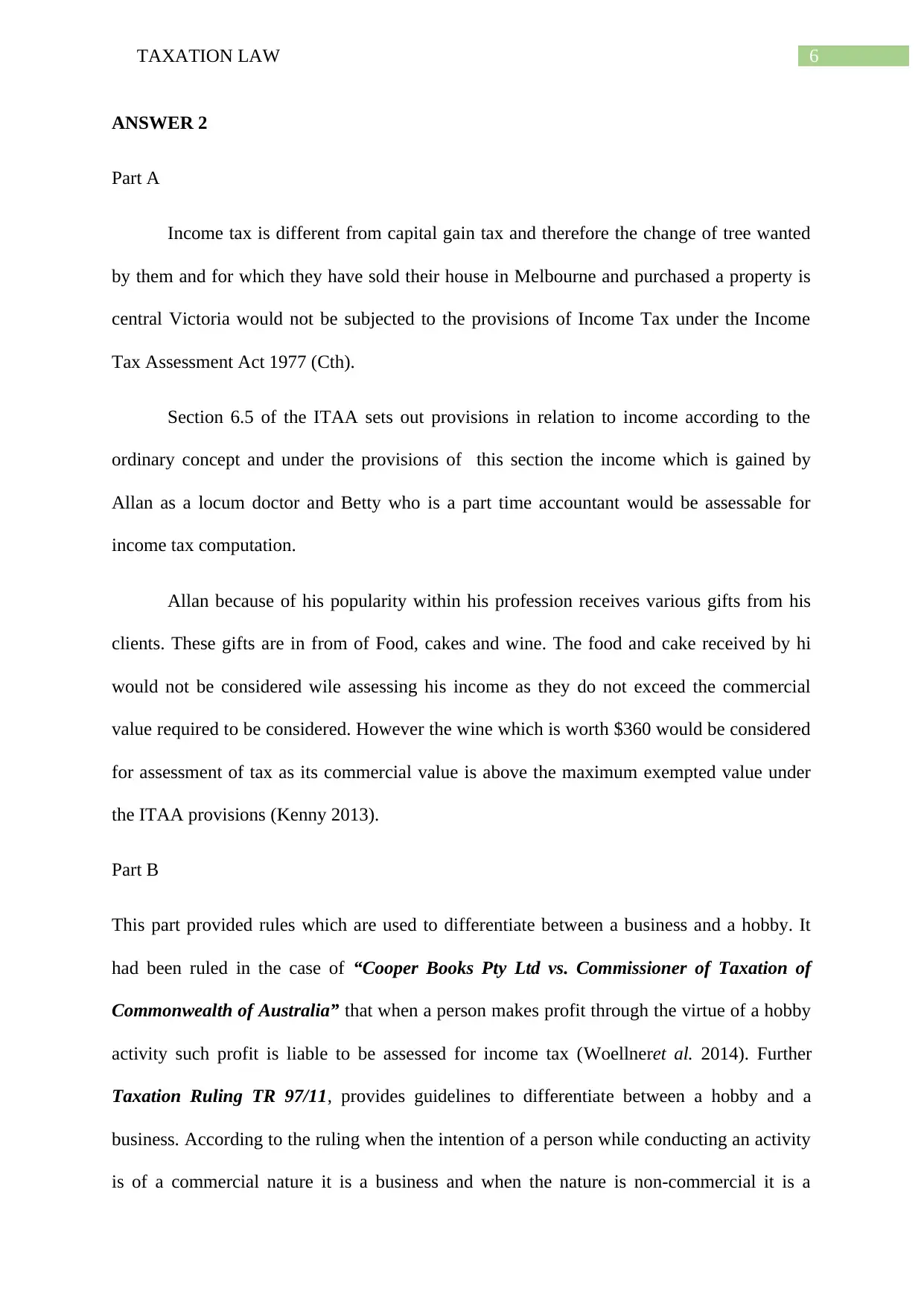
6TAXATION LAW
ANSWER 2
Part A
Income tax is different from capital gain tax and therefore the change of tree wanted
by them and for which they have sold their house in Melbourne and purchased a property is
central Victoria would not be subjected to the provisions of Income Tax under the Income
Tax Assessment Act 1977 (Cth).
Section 6.5 of the ITAA sets out provisions in relation to income according to the
ordinary concept and under the provisions of this section the income which is gained by
Allan as a locum doctor and Betty who is a part time accountant would be assessable for
income tax computation.
Allan because of his popularity within his profession receives various gifts from his
clients. These gifts are in from of Food, cakes and wine. The food and cake received by hi
would not be considered wile assessing his income as they do not exceed the commercial
value required to be considered. However the wine which is worth $360 would be considered
for assessment of tax as its commercial value is above the maximum exempted value under
the ITAA provisions (Kenny 2013).
Part B
This part provided rules which are used to differentiate between a business and a hobby. It
had been ruled in the case of “Cooper Books Pty Ltd vs. Commissioner of Taxation of
Commonwealth of Australia” that when a person makes profit through the virtue of a hobby
activity such profit is liable to be assessed for income tax (Woellneret al. 2014). Further
Taxation Ruling TR 97/11, provides guidelines to differentiate between a hobby and a
business. According to the ruling when the intention of a person while conducting an activity
is of a commercial nature it is a business and when the nature is non-commercial it is a
ANSWER 2
Part A
Income tax is different from capital gain tax and therefore the change of tree wanted
by them and for which they have sold their house in Melbourne and purchased a property is
central Victoria would not be subjected to the provisions of Income Tax under the Income
Tax Assessment Act 1977 (Cth).
Section 6.5 of the ITAA sets out provisions in relation to income according to the
ordinary concept and under the provisions of this section the income which is gained by
Allan as a locum doctor and Betty who is a part time accountant would be assessable for
income tax computation.
Allan because of his popularity within his profession receives various gifts from his
clients. These gifts are in from of Food, cakes and wine. The food and cake received by hi
would not be considered wile assessing his income as they do not exceed the commercial
value required to be considered. However the wine which is worth $360 would be considered
for assessment of tax as its commercial value is above the maximum exempted value under
the ITAA provisions (Kenny 2013).
Part B
This part provided rules which are used to differentiate between a business and a hobby. It
had been ruled in the case of “Cooper Books Pty Ltd vs. Commissioner of Taxation of
Commonwealth of Australia” that when a person makes profit through the virtue of a hobby
activity such profit is liable to be assessed for income tax (Woellneret al. 2014). Further
Taxation Ruling TR 97/11, provides guidelines to differentiate between a hobby and a
business. According to the ruling when the intention of a person while conducting an activity
is of a commercial nature it is a business and when the nature is non-commercial it is a
Paraphrase This Document
Need a fresh take? Get an instant paraphrase of this document with our AI Paraphraser
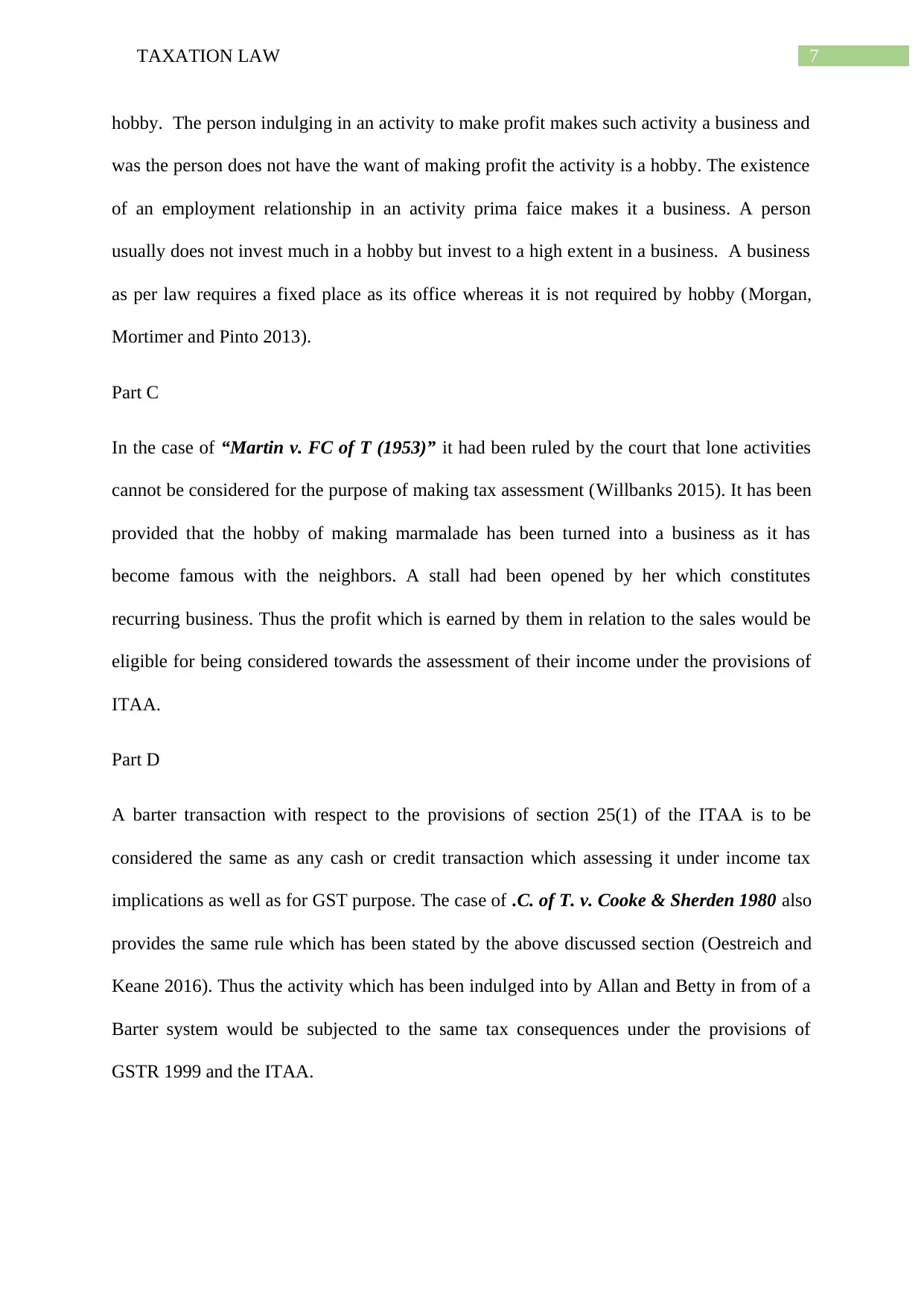
7TAXATION LAW
hobby. The person indulging in an activity to make profit makes such activity a business and
was the person does not have the want of making profit the activity is a hobby. The existence
of an employment relationship in an activity prima faice makes it a business. A person
usually does not invest much in a hobby but invest to a high extent in a business. A business
as per law requires a fixed place as its office whereas it is not required by hobby (Morgan,
Mortimer and Pinto 2013).
Part C
In the case of “Martin v. FC of T (1953)” it had been ruled by the court that lone activities
cannot be considered for the purpose of making tax assessment (Willbanks 2015). It has been
provided that the hobby of making marmalade has been turned into a business as it has
become famous with the neighbors. A stall had been opened by her which constitutes
recurring business. Thus the profit which is earned by them in relation to the sales would be
eligible for being considered towards the assessment of their income under the provisions of
ITAA.
Part D
A barter transaction with respect to the provisions of section 25(1) of the ITAA is to be
considered the same as any cash or credit transaction which assessing it under income tax
implications as well as for GST purpose. The case of .C. of T. v. Cooke & Sherden 1980 also
provides the same rule which has been stated by the above discussed section (Oestreich and
Keane 2016). Thus the activity which has been indulged into by Allan and Betty in from of a
Barter system would be subjected to the same tax consequences under the provisions of
GSTR 1999 and the ITAA.
hobby. The person indulging in an activity to make profit makes such activity a business and
was the person does not have the want of making profit the activity is a hobby. The existence
of an employment relationship in an activity prima faice makes it a business. A person
usually does not invest much in a hobby but invest to a high extent in a business. A business
as per law requires a fixed place as its office whereas it is not required by hobby (Morgan,
Mortimer and Pinto 2013).
Part C
In the case of “Martin v. FC of T (1953)” it had been ruled by the court that lone activities
cannot be considered for the purpose of making tax assessment (Willbanks 2015). It has been
provided that the hobby of making marmalade has been turned into a business as it has
become famous with the neighbors. A stall had been opened by her which constitutes
recurring business. Thus the profit which is earned by them in relation to the sales would be
eligible for being considered towards the assessment of their income under the provisions of
ITAA.
Part D
A barter transaction with respect to the provisions of section 25(1) of the ITAA is to be
considered the same as any cash or credit transaction which assessing it under income tax
implications as well as for GST purpose. The case of .C. of T. v. Cooke & Sherden 1980 also
provides the same rule which has been stated by the above discussed section (Oestreich and
Keane 2016). Thus the activity which has been indulged into by Allan and Betty in from of a
Barter system would be subjected to the same tax consequences under the provisions of
GSTR 1999 and the ITAA.
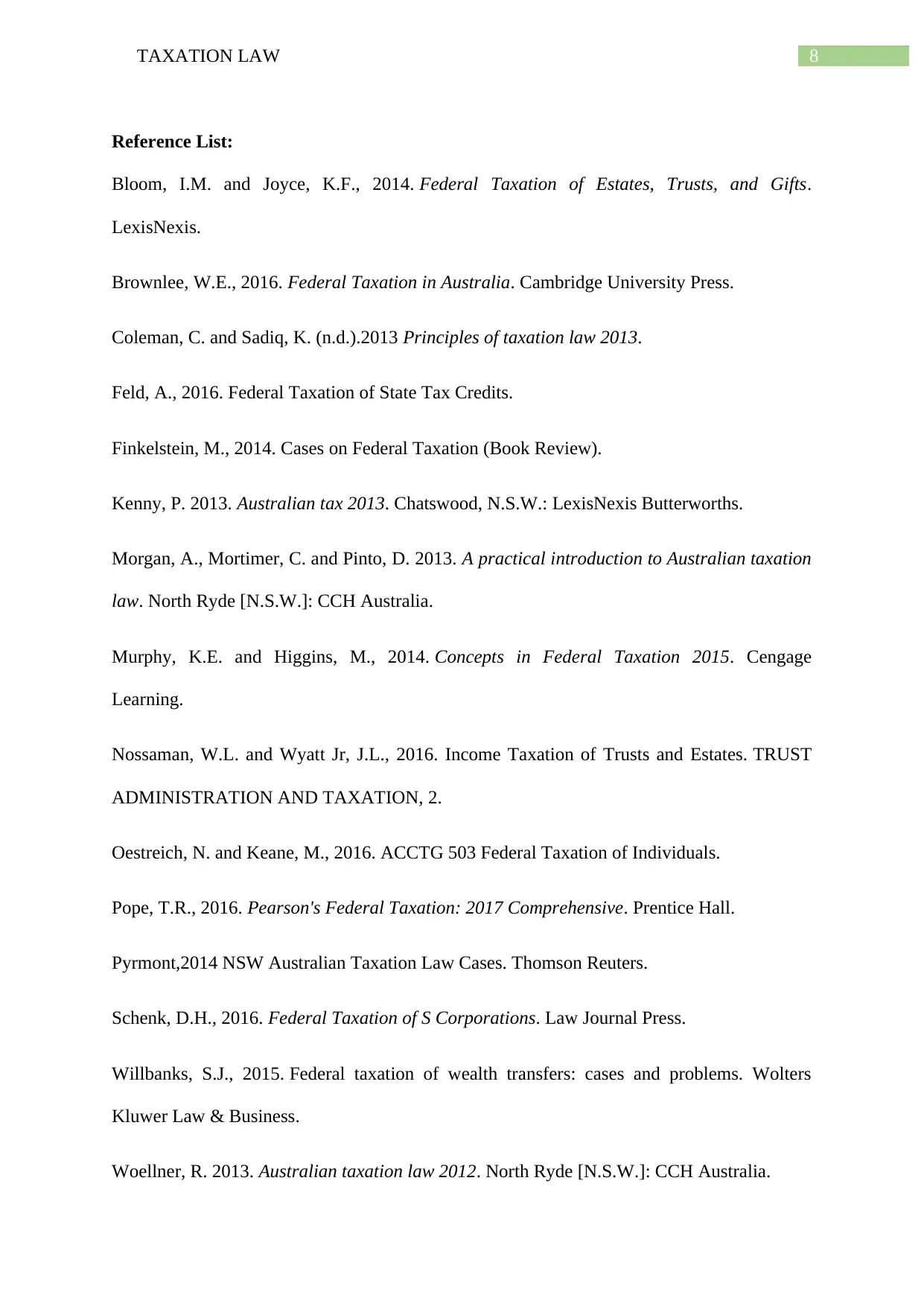
8TAXATION LAW
Reference List:
Bloom, I.M. and Joyce, K.F., 2014. Federal Taxation of Estates, Trusts, and Gifts.
LexisNexis.
Brownlee, W.E., 2016. Federal Taxation in Australia. Cambridge University Press.
Coleman, C. and Sadiq, K. (n.d.).2013 Principles of taxation law 2013.
Feld, A., 2016. Federal Taxation of State Tax Credits.
Finkelstein, M., 2014. Cases on Federal Taxation (Book Review).
Kenny, P. 2013. Australian tax 2013. Chatswood, N.S.W.: LexisNexis Butterworths.
Morgan, A., Mortimer, C. and Pinto, D. 2013. A practical introduction to Australian taxation
law. North Ryde [N.S.W.]: CCH Australia.
Murphy, K.E. and Higgins, M., 2014. Concepts in Federal Taxation 2015. Cengage
Learning.
Nossaman, W.L. and Wyatt Jr, J.L., 2016. Income Taxation of Trusts and Estates. TRUST
ADMINISTRATION AND TAXATION, 2.
Oestreich, N. and Keane, M., 2016. ACCTG 503 Federal Taxation of Individuals.
Pope, T.R., 2016. Pearson's Federal Taxation: 2017 Comprehensive. Prentice Hall.
Pyrmont,2014 NSW Australian Taxation Law Cases. Thomson Reuters.
Schenk, D.H., 2016. Federal Taxation of S Corporations. Law Journal Press.
Willbanks, S.J., 2015. Federal taxation of wealth transfers: cases and problems. Wolters
Kluwer Law & Business.
Woellner, R. 2013. Australian taxation law 2012. North Ryde [N.S.W.]: CCH Australia.
Reference List:
Bloom, I.M. and Joyce, K.F., 2014. Federal Taxation of Estates, Trusts, and Gifts.
LexisNexis.
Brownlee, W.E., 2016. Federal Taxation in Australia. Cambridge University Press.
Coleman, C. and Sadiq, K. (n.d.).2013 Principles of taxation law 2013.
Feld, A., 2016. Federal Taxation of State Tax Credits.
Finkelstein, M., 2014. Cases on Federal Taxation (Book Review).
Kenny, P. 2013. Australian tax 2013. Chatswood, N.S.W.: LexisNexis Butterworths.
Morgan, A., Mortimer, C. and Pinto, D. 2013. A practical introduction to Australian taxation
law. North Ryde [N.S.W.]: CCH Australia.
Murphy, K.E. and Higgins, M., 2014. Concepts in Federal Taxation 2015. Cengage
Learning.
Nossaman, W.L. and Wyatt Jr, J.L., 2016. Income Taxation of Trusts and Estates. TRUST
ADMINISTRATION AND TAXATION, 2.
Oestreich, N. and Keane, M., 2016. ACCTG 503 Federal Taxation of Individuals.
Pope, T.R., 2016. Pearson's Federal Taxation: 2017 Comprehensive. Prentice Hall.
Pyrmont,2014 NSW Australian Taxation Law Cases. Thomson Reuters.
Schenk, D.H., 2016. Federal Taxation of S Corporations. Law Journal Press.
Willbanks, S.J., 2015. Federal taxation of wealth transfers: cases and problems. Wolters
Kluwer Law & Business.
Woellner, R. 2013. Australian taxation law 2012. North Ryde [N.S.W.]: CCH Australia.
⊘ This is a preview!⊘
Do you want full access?
Subscribe today to unlock all pages.

Trusted by 1+ million students worldwide
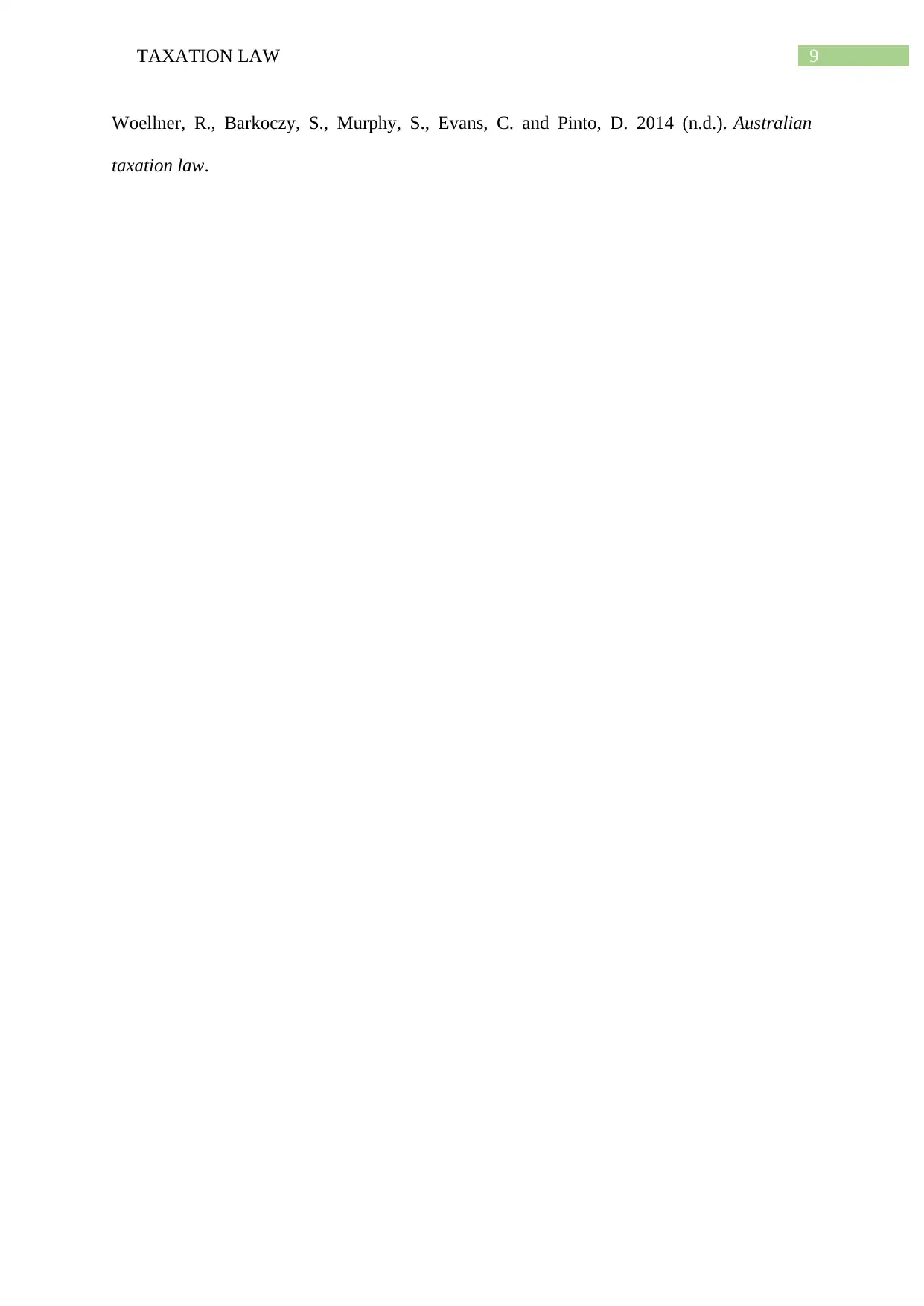
9TAXATION LAW
Woellner, R., Barkoczy, S., Murphy, S., Evans, C. and Pinto, D. 2014 (n.d.). Australian
taxation law.
Woellner, R., Barkoczy, S., Murphy, S., Evans, C. and Pinto, D. 2014 (n.d.). Australian
taxation law.
1 out of 10
Related Documents
Your All-in-One AI-Powered Toolkit for Academic Success.
+13062052269
info@desklib.com
Available 24*7 on WhatsApp / Email
![[object Object]](/_next/static/media/star-bottom.7253800d.svg)
Unlock your academic potential
Copyright © 2020–2025 A2Z Services. All Rights Reserved. Developed and managed by ZUCOL.





